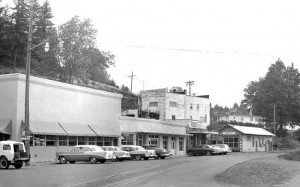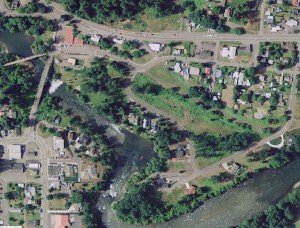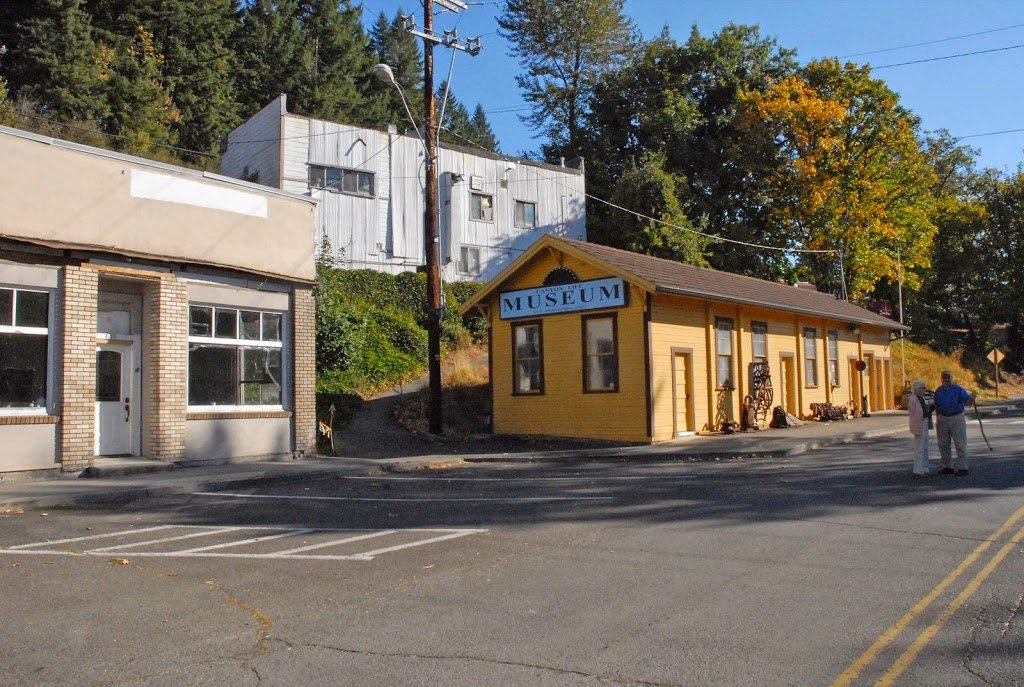 |
| Cars line Wall Street, Mill City, 1961 |
Slow down as you pass Mill City on North Santiam Highway. You don’t want to miss the turn into 1st Avenue. Continue around a curve, then take a left at NE Wall Street. You are now in the one block that was the heart of the historic city with the “wall” of a hill to the left and the fall of land to the river at right.
Perhaps it was near here that the first cabin was built by Newton Hensley in about 1874. Sarah Hensley, his mother, had bought 160 acres on the north side of the North Santiam. Their cabin was built “on the flat near the river”. But the rough trails between their cabin and supplies proved too difficult and they returned to Salem. Imagine the long, primitive 30-mile trail!
In 1887, anticipating the need for construction lumber by Oregon Pacific Railroad Company advancing east across the state, four Stayton businessmen: John Shaw, Leander Brown, Thomas Simms and W. Hadley Hobson incorporated the Santiam Lumbering Company. They moved their sawmill to this site, naming it Mill City. Building began immediately and a letter from a resident to the newspaper in Salem describes the new town as having a “well-managed store, a restaurant, a hotel and a blacksmith’s shop…” He adds that a saloon is located “on the outskirts”. Shaw managed the mill, a store and a post office.
Santiam Lumbering Company purchased half of Sarah Hensley’s property. A few months later, she returned, now as Mrs. Richard Rice, and built a house near Elizabeth Creek. In 1888, Richard Rice’s plat for the town of Mill City was recorded with Marion County. It included streets named Elizabeth and Lucy (for Mrs. Rice’s daughter). Lucy Street in now NE 4th Street. In the next year, the Santiam Lumbering Company built a hotel on the cliff above the mill, naming it Cliff House. When railroad reached the booming town in November 1888, John Shaw, now company manager, lived with his family on the upper floor of a building housing a post office, ticket office, Wells Fargo facility and railroad office. In 1890 work on the Oregon Pacific Railroad ceased after rails reached Idanha. The company defaulted on its bonds and went into receivership. The Santiam Lumbering Company closed its mill in 1893. In 1894 the properties were acquired in a sheriff’s auction ($100,000) by A. B. Hammond, a lumberman from Missoula, Montana. He expanded the mill, store and other services, including a theater, The Opera House. (He operated the railroad until 1907 when he sold it to Southern Pacific for a nice profit at $1,400,000).
In 1903, Mill City was described as having a large sawmill, Presbyterian Church, long distance telephone service for its population of 250, daily mail, general store, hotel, saloon, grocery, blacksmith, and meat market. Civic organizations before 1914 were Odd Fellows and Rebekahs, Ancient Order of United Workers, Masonic Lodge and Eastern Star, and Women’s Benefit Association. But it was still a small community: in 1929 the Salem Capitol Journal reported Taylor School on the ridge above the city was the only one in Marion County that Superintendent Mary L. Fulkerson could not reach by automobile. Also, it was the smallest school with only Johnny, Norman and Iva Short as pupils. (Gates and Mill City school districts were united in 1963.)
In 1935, the same newspaper reported that the Mill City Hospital, owned and operated by W.W. Allen, was completely destroyed by fire. Loss was estimated at between $10,000 and $15,000 with only a few surgical instruments saved. It had been equipped to house 12 to 25 patients. Three years later, the Alfred G. “Simon” Hinkle residence was acquired in the name of Harriet Reid, according to a National Register of Historic Places document. Her husband, Dr. David Reid, and his son, John, used the house as a residence and lumber company medical facility until 1946. The 1916 Craftsman-style Hinkle-Reid House at 525 NE Alder Street is listed on the National Register of Historic Places.
 |
| Mill City of Marion County |
The city was incorporated in 1947 and a new prosperity began in 1948 with the proposed construction of Detroit Dam, 12 miles upstream. The arrival of engineers and workmen encouraged private investment and community services. With the completion of the dam in 1953, the primary investments returned to lumbering, however the Hammond Lumber Company was dismantled in 1957. The last train left the city in 1971.
Today the scenic North Santiam River divides a city of 1,855 residents. We began our visit by parking on the deserted Wall Street. The block contains the shell of a two-story company store, the post office, newspaper office and bank. The adjacent depot is now the Canyon Life Museum. Unfortunately, we found it closed. We lingered on the roadway, glancing at the empty space along river to the south where there were once lumbering structures, all now gone.
To west, we saw where the rail line entered Wall Street, crossing the river. The bridge, long unused, has been converted for pedestrians. We choose that route into the city, instead of continuing on 1st Street’s traffic bridge. We enjoyed the river views and chatting with other strollers. After 1919, when it was relocated from its original 1888 location in San Jose, California, this railroad bridge provided transportation for the local lumber mills, as well as those coming to work on the local dams. Its handsome renovation is an example of Mill City using an asset to best advantage.
We were wandering through the newer portion of the city in Linn County, passing the building with City Hall, Sheriff Sub-Station and library when I stuck my hand into my jeans pocket and discovered my iPhone was missing. Panicking, I retraced my steps, Tom following in the car, both of us carefully examining the sidewalks to see if the phone had dropped to the pavement. Since the library was the only municipal facility open, I reported the loss there. A few minutes later, I found the iPhone had dropped between the seats in Tom’s car and reported our discovery to the librarian. After identifying ourselves as historians and remarking that we were sorry to miss a visit to the museum, a patron (who had the keys) offered to open the museum for us and so we had a private tour: what luck! We found Canyon Life Museum a good starting point for anyone interested in photographs and history of the booming lumber mill days. By establishing the museum in the original railroad depot, Mill City has used another valuable site for a new purpose. The publication 100 years in the Santiam Canyon may be purchased there for $5. There is no charge for the brochure, “Welcome to Canyon Life Museum”.
 |
| Canyon Life Museum |
After the museum visit, we drove by the National Register Hinkle-Reid House on East Alder. We later discovered that by continuing east and south from Wall Street, the road leads to Santiam Pointe Loop, a neighborhood of recent residential development within the bend of the river in Marion County.
Two additional sources of information about Mill City are the North Santiam Chamber of Commerce visitors guide (which can be picked up at Green Mountain Real Estate and at Mountain Edge Cafe) and the Canyon Weekly, available by subscription through the online edition.
If you are a casual visitor, as we were, we would also suggest you plan ahead if you wish to visit this fascinating, local museum. You may not be as lucky as we were.
Each Tuesday, after a city was featured in that Sunday’s Statesman Journal, KMUZ broadcasted “Marion County 20”. To learn more about Mill City, listen to the podcast listed on the KMUZ archives.
